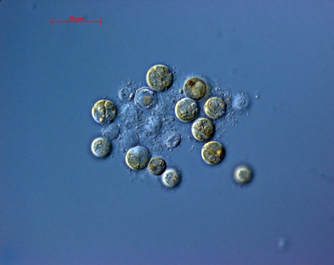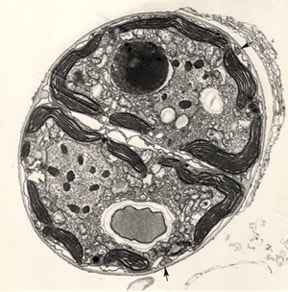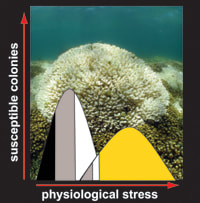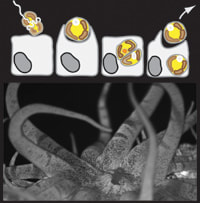Overview
Reef-building corals are mutualisms between calcifying cnidarians (scleractinia) and photosynthetic endosymbionts, dinoflagellates in the family Symbiodiniaceae (formerly genus Symbiodinium), also called zooxanthellae. These photosynthetic unicellular protists provide the chemical energy for constructing and sustaining the most diverse of marine ecosystems on the planet. Unfortunately, their animal partnerships have exhibited extreme sensitivity to anomalous spikes in sea surface temperature, attributed to El Niño Southern Oscillations events and global warming. Corals reefs have shown remarkable resiliency in times of severe climate change over immense geological time. Ironically, these ecosystems are now among the most endangered on the planet. The continued mass mortality of coral communities threatens the loss of thousands, and potentially millions, of marine species and the economies of numerous countries.
To advance the limited understanding of this system, my students and I conduct basic research that focuses primarily on the ecology, biogeography and evolution of zooxanthellae. As with most microbes, their cryptic morphology and difficulty in culturing have made them a challenge to study in the past. This has changed with the development and application of molecular based approaches. Indeed, the molecular revolution has initiated a renaissance of discovery concerning the diversity, ecology, evolution, and systematics of all microscopic life.
To advance the limited understanding of this system, my students and I conduct basic research that focuses primarily on the ecology, biogeography and evolution of zooxanthellae. As with most microbes, their cryptic morphology and difficulty in culturing have made them a challenge to study in the past. This has changed with the development and application of molecular based approaches. Indeed, the molecular revolution has initiated a renaissance of discovery concerning the diversity, ecology, evolution, and systematics of all microscopic life.
Biodiversity and biogeography

Arguably, Symbiodiniaceae are among the most common protists in shallow tropical marine ecosystems. Meticulous and consistent identification of ecologically distinct and reproductively isolated organisms (i.e. species) is vital for properly deducing underlying ecological and evolutionary processes. In other words, good taxonomic delineation enables good science. We use a variety of molecular genetic analyses to characterize the community diversity, host specificity and geographic range of symbiotic dinoflagellates associated with animal hosts. These fundamental observations are yielding considerable knowledge about host-symbiont specificity and how biological and environmental factors govern these partnerships. These data will also serve as a baseline for tracking host-symbiont communities as they respond to increasing sea surface temperatures.
Speciation in Eukaryotic Microbes

The microevolution of most microorganisms is poorly understood since culturing is often required in order to obtain enough material upon which to conduct population genetic analyses. Unfortunately, culturing is time consuming and highly selective. As a result, it retrieves only a fraction of the natural diversity that is present. This is also the case when culturing Symbiodiniaceae. A major component of my research program is to develop and use genetic markers that delineate boundaries of genetic recombination among zooxanthellae (e.g. PCR-DGGE analysis of rDNA and microsatellites). From sampling host tissues we obtain high cell numbers of genetically homogenous Symbiodiniaceae to conduct genetic studies addressing potential "species" boundaries and population structure. An abundance and diversity of host taxa from regions around the world provide a predictable and plentiful source of these microbes at various geographical scales. While they are foremost unicellular symbionts, the examination of their ecology and evolution may have broader relevance toward understanding how these processes operate among protists in general.
The development of population genetic markers opens possibilities to address many additional questions. These include learning of the importance of clonal propagation versus sexual recombination. Preliminary findings show that a single clonal line of Symbiodiniaceae dominates most coral colonies and that these associations are stable for many years and may persist until the death of the host. Reef-wide populations of symbiont are "epidemic;" that is, host populations on a given reef typically associate with a few common symbiont genotypes. Certain genotypes are more widely dispersed than others and may offer evidence for connectivity among reefs systems. Finally, as haploids these organisms are far more responsive to changes in selection pressure than their hosts. What happens to these symbiont populations at the clone level following episodes of severe thermal stress may provide insight into their evolution during periods of climate change.
Finally, do the ecological and evolutionary processes important in Symbiodiniaceae speciation apply to other photosynthetic eukaryotes (e.g. phytoplankton)? To test this we are comparing what we know about Symbiodiniaceae with "free-living" dinoflagellates. For example, Kerenia spp. and Alexandrium spp. are toxic species responsible for red tides in various regions around the world and so, like Symbiodiniaceae, it has ecological and economic importance. Determining how genetic structure and distribution differs between the two groups will offer a good comparison for determining how life history (free-living vs. symbiotic) may or may not influence the ecology and evolution of micro-algae.
The development of population genetic markers opens possibilities to address many additional questions. These include learning of the importance of clonal propagation versus sexual recombination. Preliminary findings show that a single clonal line of Symbiodiniaceae dominates most coral colonies and that these associations are stable for many years and may persist until the death of the host. Reef-wide populations of symbiont are "epidemic;" that is, host populations on a given reef typically associate with a few common symbiont genotypes. Certain genotypes are more widely dispersed than others and may offer evidence for connectivity among reefs systems. Finally, as haploids these organisms are far more responsive to changes in selection pressure than their hosts. What happens to these symbiont populations at the clone level following episodes of severe thermal stress may provide insight into their evolution during periods of climate change.
Finally, do the ecological and evolutionary processes important in Symbiodiniaceae speciation apply to other photosynthetic eukaryotes (e.g. phytoplankton)? To test this we are comparing what we know about Symbiodiniaceae with "free-living" dinoflagellates. For example, Kerenia spp. and Alexandrium spp. are toxic species responsible for red tides in various regions around the world and so, like Symbiodiniaceae, it has ecological and economic importance. Determining how genetic structure and distribution differs between the two groups will offer a good comparison for determining how life history (free-living vs. symbiotic) may or may not influence the ecology and evolution of micro-algae.
Functional Diversity of Host-Symbiont Partnerships

The next major phase in coral symbiosis research should involve large-scale physiological comparisons between host colonies harboring different symbiont species. This involves the concept of the holobiont and asks, what is the functionality of certain partnerships and how do physiological differences in partner combinations translate into larger ecological and evolutionary outcomes? How do certain host-symbiont combinations, for example, influence colony growth rate, fecundity and resilience to thermal stress? In collaboration with Dr. Mark Warner at the University of Delaware and Dr. Dustin Kemp at the University of Alabama at Birmingham, we are monitoring and experimentally manipulating symbiotic associations of hundreds of coral colonies at study sites in Palau to determine the effect of symbiont identity on physiology, gene expression, nutrient storage, and response to heat stress.
Knowledge and technology for keeping corals has advanced to such a level that closed systems can be established and maintained at any location. Maintaining live coral colonies has proven to be a major asset for our lab. These colonies thrive in a closed system where temperature, pH, and waste contaminants are monitored. Access to hermatypic corals provides convenient material for physiological experiments and genetic analyses.
How corals will ultimately respond to rapid oceanic warming is widely speculated. A controversial hypothesis asserts that corals will quickly "acclimate" by forming novel associations with thermally tolerant symbionts. Understanding the factors controlling different combinations of host and symbiont species, and the physiological and ecological implications of this possibility, will go a long way in determining how corals, and the ecosystems they support, "adjust" to environmental change.
Knowledge and technology for keeping corals has advanced to such a level that closed systems can be established and maintained at any location. Maintaining live coral colonies has proven to be a major asset for our lab. These colonies thrive in a closed system where temperature, pH, and waste contaminants are monitored. Access to hermatypic corals provides convenient material for physiological experiments and genetic analyses.
How corals will ultimately respond to rapid oceanic warming is widely speculated. A controversial hypothesis asserts that corals will quickly "acclimate" by forming novel associations with thermally tolerant symbionts. Understanding the factors controlling different combinations of host and symbiont species, and the physiological and ecological implications of this possibility, will go a long way in determining how corals, and the ecosystems they support, "adjust" to environmental change.
Molecular and cellular interactions

From molecules to ecosystems, the study of life is hierarchical. Basic understanding at one level of organization informs us about processes operating at the next higher level. Interactions between hosts and symbionts appear remarkably specific and stable. Secondarily are external environmental factors important in modulating these interactions. These patterns of association suggest the importance of cellular/molecular interactions in shaping and maintaining cnidarian/dinoflagellate symbioses. However, little is known about the molecular communication occurring at the cellular interface between cnidarian and dinoflagellate cells.
Decisions by scientific communities to establish and study model organisms have revolutionized our understanding of molecular-genetic, cell signaling, and developmental processes. Until very recently, investigators have lacked a model system with which to examine animal-microbe mutualisms at the molecular/cellular level. The small tropical sea anemone, Exaiptasia sp., possesses a number of valuable traits that allow for its easy maintenance and manipulation. Gaining knowledge about these interactions may also complement research conducted on parasitic animal-microbe interactions such as malaria, a serious disease caused by eukaryotic microbes belonging to the sister lineage of dinoflagellates.
Decisions by scientific communities to establish and study model organisms have revolutionized our understanding of molecular-genetic, cell signaling, and developmental processes. Until very recently, investigators have lacked a model system with which to examine animal-microbe mutualisms at the molecular/cellular level. The small tropical sea anemone, Exaiptasia sp., possesses a number of valuable traits that allow for its easy maintenance and manipulation. Gaining knowledge about these interactions may also complement research conducted on parasitic animal-microbe interactions such as malaria, a serious disease caused by eukaryotic microbes belonging to the sister lineage of dinoflagellates.
